🇨🇦 Phaserunner

Phaserunner V6s are finally in! With a few updates to this latest version. First, all the connectors have been upgraded to waterproof connectors, like the Frankenrunners and latest version of the Baserunners. Additionally, a demux chip has been added, so speed and temperature signals can be sent to the controller on the same signal line. Finally, they use V6 ASI firmware, which means better future compatibility with 3rd party displays. Currently only the L10 version is available, with the MT version expected late summer 2023.
Introduction
The Phaserunner is a compact state-of-the-art field oriented motor controller (FOC) from Grin Technologies based around the sophisticated control electronics from Accelerated Systems Inc. of Waterloo. It is ideally suited for running brushless motors for electric vehicles in the 500-2000 Watt power range, and once you have experienced the smooth response of a FOC with a torque throttle it's hard to go back to the setup you had before.
This controller was designed as a universal device that can fit on almost any bicycle frame and handle almost any motor system. You can power it from a 24V battery or a 72V battery, and run your phase current to peaks of 90 amps, though the continuous current capability without additional heatsinking is typically 45-50A. The wiring is pared down to the bare basics for a nice clutter-free installation with two models for different applications. The Phaserunner_L10 has a cable exit for compatibility with all the motors supplied by Grin with the L1019 connector, while the Phaserunner_MT is connectorized for separate cable harnesses between the controller and motor.
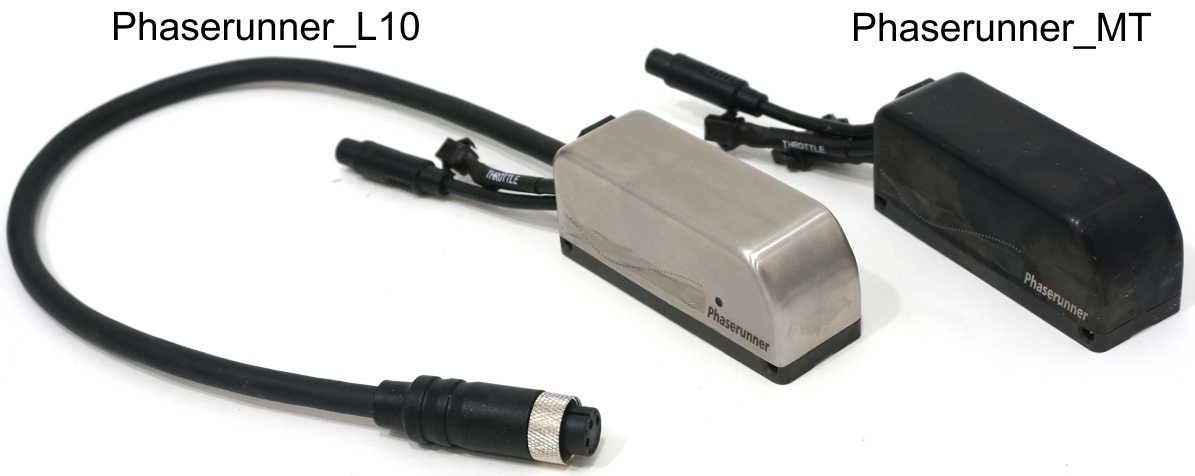
Features
- Remote on/off switch compatible
- Compatible with new CA3-WP display and control device
- Proportional regen available through throttle signal or stand-alone wire
- Works both sensored and sensorless, and even with very high eRPMs
- Waterproof, with 100% potted electronics and new waterproof connectors
- Fully programmable parameters (regen voltage, max phase and battery currents, etc.)
- Field Weakening allows you to run motors faster than normal back-emf limit
- Virtual Electronic Freewheeling allows you to experience zero drag with direct drive motors
- Higher motor efficiency than typical trapezoidal controllers
- Torque-based throttle command (no twitchy throttle with powerful systems)
- Wide operating voltage range from 20V to 90V (21S Li-Ion, 24s LiFe)
- Automatic thermal rollback to prevent controller overheating
- Demux chip to separate speed and temperature signals sent on the same signal line
Cables and Connectors
Both models of the Phaserunner V6 use the same connectors for the battery, Cycle Analyst, mains, PAS, and communication plugs, but they differ in how they hook up to the motor.
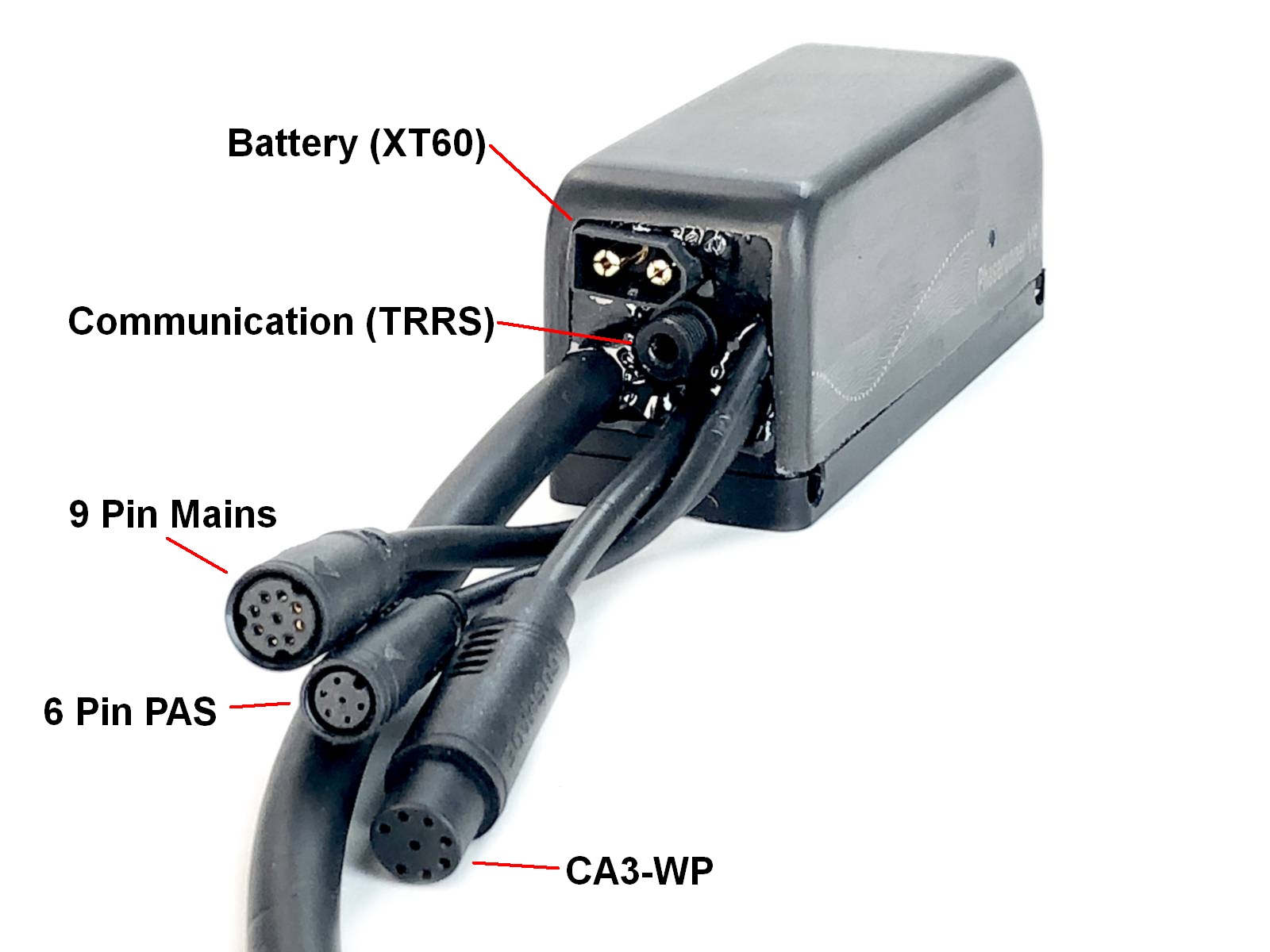
 |
Battery - XT60: The hookup for the battery pack is with an embedded XT60 style male bullet connector. Each Phaserunner includes an 80cm battery cable terminated with an XT60 female plug at one end and Anderson Powerpoles on the other for hookup to your battery pack. We recommend not using the XT60 plug for making a live connection to the battery as the inrush current spark to the controller capacitors can damage the gold-plated bullet plugs. |
 |
CA Display - WP8: The Phaserunner V6 uses the waterproof WP8 Cycle Analyst plug standard which includes motor temperature and on/off power lines to the CA3. Please use the WP8->JST adapter for use with older models of Cycle Analyst using the 6-pin JST-SM plug. |
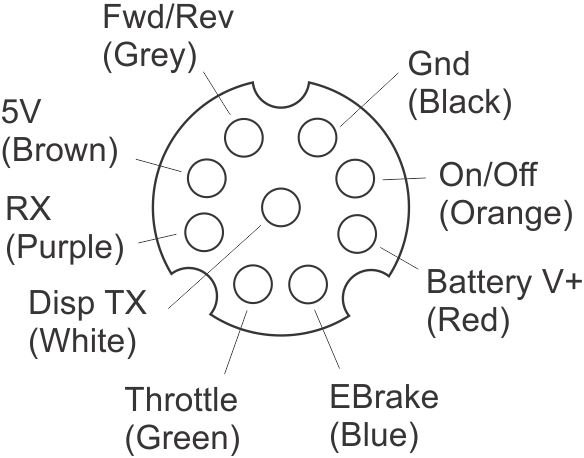 |
Mains Connector: A 9 pin plug provides all the signals needed for conventional ebike wiring harness strategies where the throttle and ebrake connect to the motor controller and a 3rd party display has the on/off power and communicates the assist level. For the controller to turn on, the key input on either the Mains or CA plugs must be shorted to V+. |
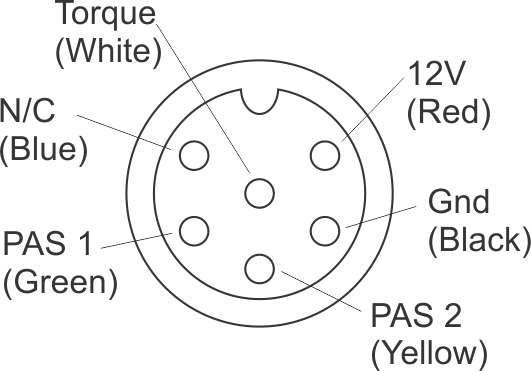 |
PAS Connector: A 6 pin HiGo plug provides an input for the direct hookup of either PAS or Torque sensors to the motor controller. This is required for pedalec ebikes that don't use a Cycle Analyst. With a Cycle Analyst system this plug is not used as the PAS sensors, throttles, and all accessories plug into the CA3 instead. |
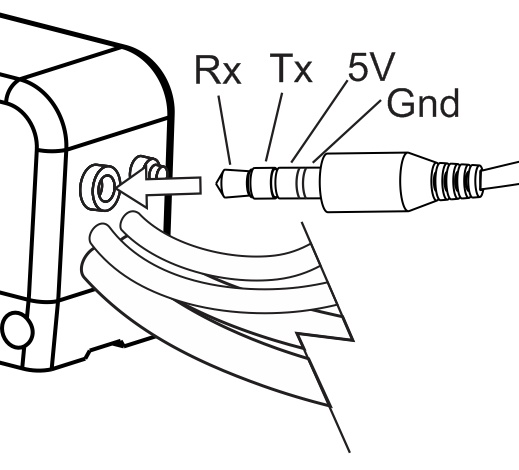 |
Communications - TRRS: The Phaserunner V6 uses a TRRS jack to support communication to computers and smart phones using our USB->TTL adapter cable. As shipped there is a rubber plug to seal this jack from water. Unlike the V2 and earlier Phaserunners which had a similar looking TRS jack, the TRRS in the Phaseurnner V6 also has 5V present to support the future release of powered serial to Bluetooth adapters. |
L10 Particulars
The only additional wire on the Phaserunner_L10 is the motor cable, which is 53cm long and terminated with the female L1019 plug for a rugged connection to Grin motors that use this connector standard
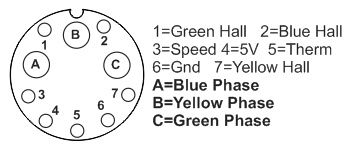 |
Motor - L1019: The motor connection on the Phaserunner_L10 is through the locking and waterproof Higo L1019 plug or the Cusmade equivalent. The cable uses 3mm^2 (12 AWG) wire for the 3 motor phase leads to support high amperage, and has a total of 7 smaller gauge signal connectors. Five of these are used for the hall signals and power, while the extra two serve for the motor temperature sensor (grey) and a wheel speed sensor (white). |
MT Particulars
On the Phaserunner_MT, the hookup between the motor and the controller is done via 3 separate plugs rather than through a single cable with an over-molded connector.
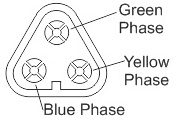 |
Motor Phase - MT60: The 3 motor phases are terminated with a male MT60 bullet connector. This compact plug supports high phase amperages in a very small connector size. |
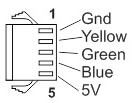 |
Motor Hall - JST-SM: The hall plug is a 5 pin female JST connector using the same pinout standard we adopted in 2008. |
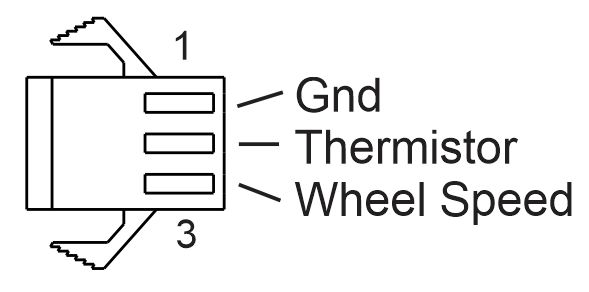 |
Speed/Thermistor Pass Thru - JST-SM: If the motor has a temperature and/or wheel speed sensor, these signals can be passed to the controller via the 3-pin plug. Both of these signals must be referenced to the Hall ground pin. |
With the Phaserunner_MT, we provide the following optional motor cable harnesses for different motor applications. The Anderson terminated cable is compatible with our hub motors sold from 2019 and earlier and is recommended for 3rd party motors for which there isn't another compatible plug type.
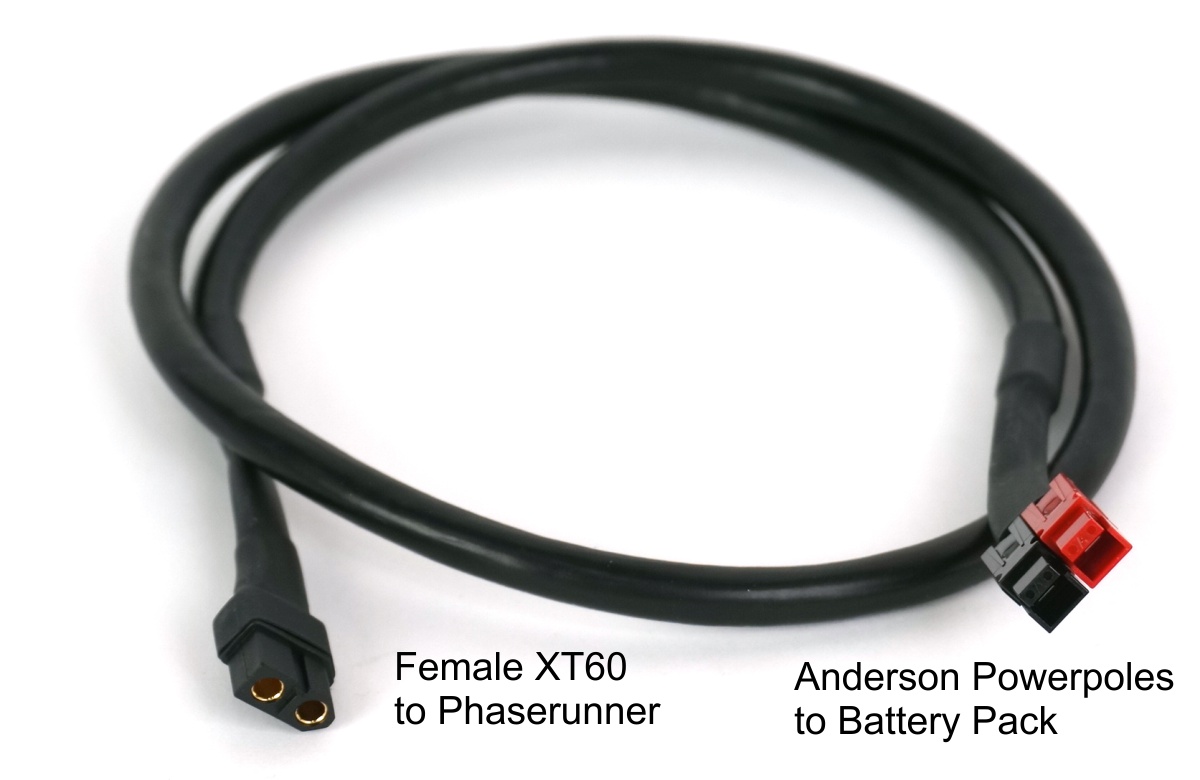 |
Battery Cable: Both Phaserunner models come stock with an 80cm long XT60 to Anderson battery cable for mating with batteries that use Anderson Powerpoles. |
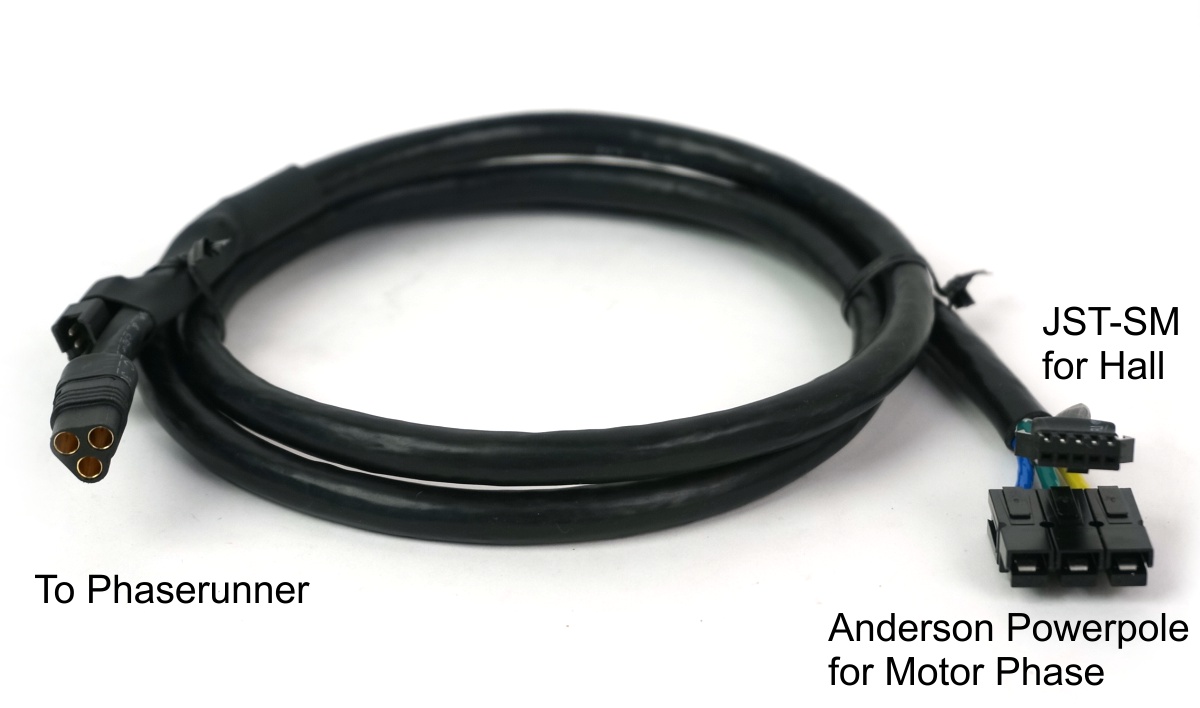 |
Stock Motor Harness: The standard motor cable has staggered MT60 and male JST-SM connectors on the controller end and Anderson and female JST-SM connectors for the motor. This is compatible with all of the medium to high power hub motors that Grin has sold since about 2009, and is available in both a short (45cm) and long (120cm) cable length option. Note that the Phaserunner is capable of delivering a high enough continuous phase current to melt the Anderson plugs, and we don't recommend using this connector in applications that will be sustaining more than 70 amps of phase current for extended periods. |
 |
HiGo Z910 Motor Harness: This cable harness terminates at the motor end with the 9 pin waterproof HiGo motor plug popular in many lower-power hub motors. We recommend limiting the phase current to no more than 50 amps with this connector harness and plug standard. Notice that if the motor has a speedometer sensor built in, that signal will not be connected to the Phaserunner's CA Plug and you will need to use a CA with an external speedo. |
 |
L1019 Motor Harness: This cable harness can be used to connect the Phaserunner_MT controller to hub motors that use the L1019 plug standard. In general, we recommend the Phaserunner_L10 model in this application, but we made this for customers who already have a Phaserunner_MT and now want to use it on a new motor with the L1019 connector. |
 |
BBSHD Motor Harness: *Discontinued* This cable harness was produced in 2019 and supported upgrading the stock internal controller in a BBSHD mid-drive system with an external Phaserunner and CA3-DPS for improved handling and higher power levels. It had motor and hall terminals that mate with the plugs present in the central motor and had a secondary cable harness to bring the PAS sensor and motor temperature signals up to the CA3-DPS on the handlebar, but has been discontinued for the reasons explained here. |
User Manuals / Drawings
Software Suite
Phaserunner Suite V2.0, Windows, Portable
Phaserunner Suite V2.0, Windows, Installer
Phaserunner Suite V2.0, macOS (Requires macOS 10.13 or newer)
If using a SuperHarness Kit, you must use Phaserunner Suite V2.0 or later.
Our now outdated Android app in the Google Playstore is no longer available until the app is updated and ready for re-release. Coming soon!
The drivers for the FTDI chipset inside the USB-TTL adapter can be found through FTDI here - https://www.ftdichip.com/Drivers/VCP.htm
Earlier Models
The Phaserunner project started off with a meeting of the founders of ASI at the Taipei Cycle Show in 2011 which led to an eventual collaboration to take their well-engineered OEM motor controllers and properly package them to be better suited to the aftermarket and DIY ebike scene. A lot of the background and product evolution can be seen in our original thread on Endless-Sphere.
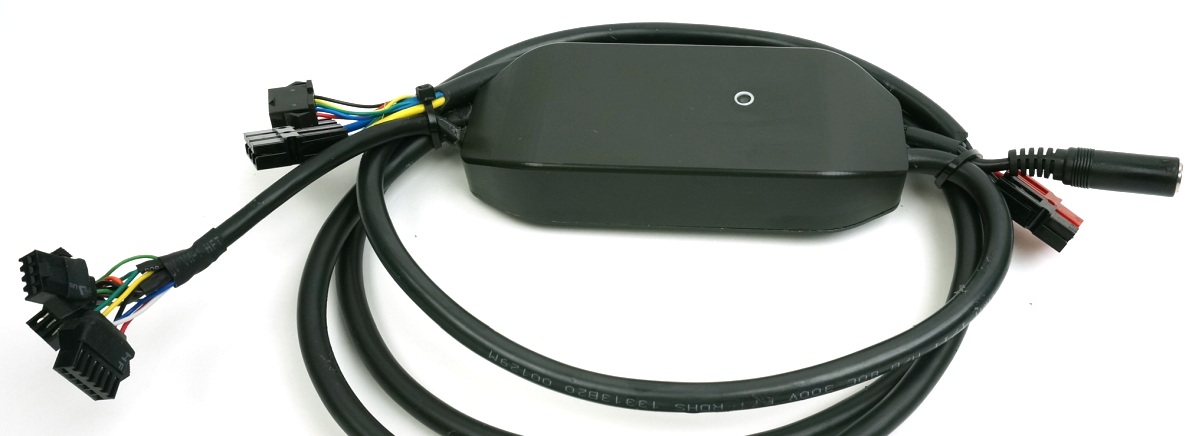 Our very first iteration of what became the Phaserunner was developed in 2013 as the BAC500+
Our very first iteration of what became the Phaserunner was developed in 2013 as the BAC500+
 The V1 Phaserunner involved a rearranged board layout for a narrower profile, it increased the voltage range to be compatible with 72V batteries, and it did away with the CNC machined enclosure in preference for a clear potted finish. This model had an integrated on/off button on the back of the controller and had cast in place battery and motor phase cables.
The V1 Phaserunner involved a rearranged board layout for a narrower profile, it increased the voltage range to be compatible with 72V batteries, and it did away with the CNC machined enclosure in preference for a clear potted finish. This model had an integrated on/off button on the back of the controller and had cast in place battery and motor phase cables.
 The V2 Phaserunner was produced from 2016-2019 and introduced the connectorized back-end with MT60 and XT60 connectors molded in place. The integrated on/off button was removed. In early 2019 we switched this design to using a stamped metal shell instead of a bare resin finish so that we could switch to a lower durometer potting resin that would put less thermal stress on the components. An option for the L1019 model was introduced at this stage too.
The V2 Phaserunner was produced from 2016-2019 and introduced the connectorized back-end with MT60 and XT60 connectors molded in place. The integrated on/off button was removed. In early 2019 we switched this design to using a stamped metal shell instead of a bare resin finish so that we could switch to a lower durometer potting resin that would put less thermal stress on the components. An option for the L1019 model was introduced at this stage too.
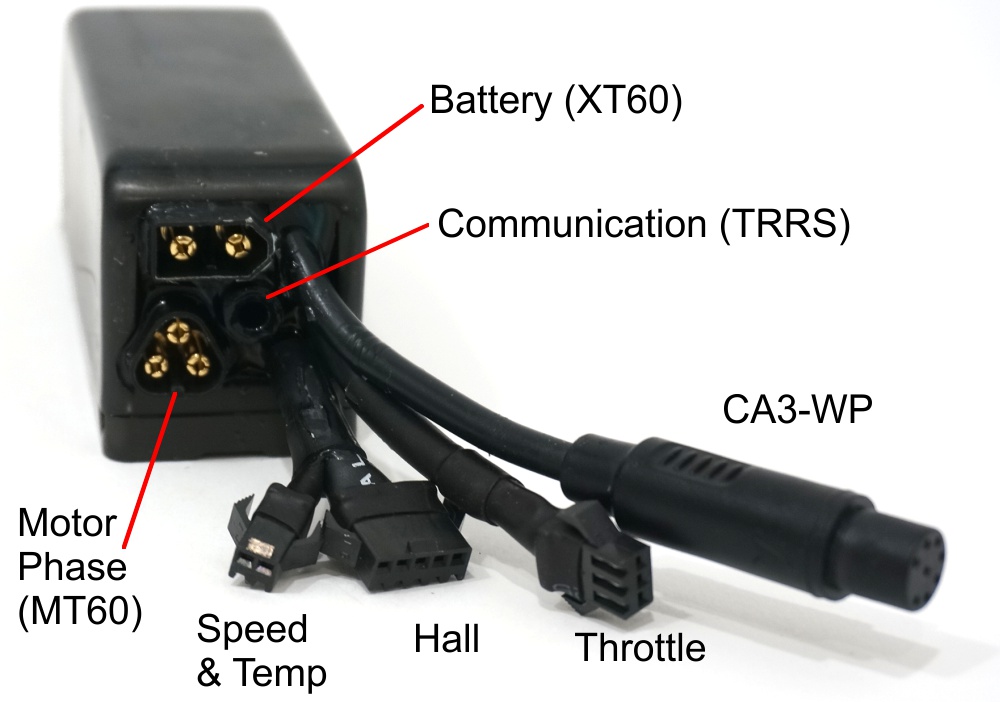 The V3 Phaserunner was produced from 2019-2021 and can be readily identified by the use of the WP8 Cycle Analyst plug instead of the 6 pin JST plug. Otherwise, it looks very similar to the later model V2 Phaserunners that used the stainless shell. By default, the on/off switch wires under the throttle heatshrink were disconnected on this model to allow the on/off button on the MF switch to function.
The V3 Phaserunner was produced from 2019-2021 and can be readily identified by the use of the WP8 Cycle Analyst plug instead of the 6 pin JST plug. Otherwise, it looks very similar to the later model V2 Phaserunners that used the stainless shell. By default, the on/off switch wires under the throttle heatshrink were disconnected on this model to allow the on/off button on the MF switch to function.
Videos
Troubleshooting
Most people are able to set up and tune the Phaserunner with relative ease using our software suite and following the direction in the user manual. Here are some of the more common troubleshooting issues that we have run into doing tech support.
No Response to Throttle: The Phaserunner controller can be configured so that the throttle input signal is mapped either to Analog Input 1 (Throttle), or Analog Input 2 (Brake1). The throttle output signal of the Cycle Analyst on the WP8 plug is wired to the Analog Input 2 (Brake1) signal source, as that allows the Cycle Analyst to activate throttle and regen from a single wire. If you are using the 9 pin mains cable, then typically you will want separate input signal wires for the throttle and the regen brake. In these cases, the throttle source must set to Analog Input 1, and the regen brake source to Analog Input 2. This is done via the custom parameter edit menu as shown in the image below.
Controller Not Turning On: The most common reason for this is that the on/off switch wiring is not wired up to turn the device on. As mentioned in the V3 Phaserunner Updates document, by default now the on/off switch wires of the controller are not shorted together. In order to power on, the Phaserunner V6's on/off wire must be shorted to battery V+, either through the WP8 plug or the 9 pin mains plug. This is accomplished either with a Cycle Analyst plugged into the WP8 plug, or one of the 9 pin mains cable options on the 9 pin plug.
Motor Not Detected During Autotune: The most common reason for this error is not that the motor is disconnected (though that will do it), but rather communication errors or delays between the software suite and the Phaserunner device. It will happen consistently if there are two instances of the Phaserunner suite open on the computer at the same time, and can also occur if there is significant electrical noise interference (noisy power supply instead of battery powering controller) on the communications cable, or if the computer is running the wrong virtual COM port driver. MAC computers are especially prone to this latter problem. If you are experiencing these issues with the V1.0x software we recommend updating to the latest V1.3 release as that has fixed a number of potential communication problems.
Instantaneous Phase Overcurrent Fault (2-2 Flash): This is a fault that typically occurs when there is a sudden change in the motor eRPM (such as hitting a pothole, or the motor transitioning from open loop to closed loop sensorless operation), and it usually means that the current regulator bandwidth and/or the PLL bandwidth are not high enough to track the dynamic motor response. Increasing both the PLL and Current Regulator in tandem will usually result in a setting that doesn't result in phase overcurrent faults. In some cases where this tuning alone is not sufficient, then the current regulator Ki and Kp terms can be adjusted independently.
POST Static Gate Fault (1-8 Flash): This fault occurs if there is some stray electrical conductivity detected between one of the phase wires and either the V+ or GND bus. It will occur if there is a blown MOSFET, if the motor wire is nicked at the axle and is shorting a phase lead to the motor casing, or if is water ingress inside the motor causing paths for electrical connectivity with the phase wires. If this message shows up, disconnect the Phaserunner from the motor, apply the throttle, and look at each of the phase open circuit voltages from the edit parameter menu. They should be around 0.5 Vnom. If you see a value of 0.00 or 1.00 Vnom, then it usually means there is a damaged MOSFET. If there is a value more like 0.2 or 0.8 Vnom, then you can increase the open circuit test window from the default of 0.25 up to about 0.4, and then it will operate fine again.
Damaged XT60 Connector: We've seen several instances with high-power rigs where the XT60 plug for the battery cable has become badly damaged from arcing, sometimes even melting the contacts. The battery current draw on the Phaserunner is much lower than what the XT60 contacts are rated for, so we believe that this failure is mostly the result of mechanical stresses on the battery leads pulling the connector at an angle and causing interruptions and arcs in the power flow. It's possible to spread apart the 4 tongs of the male pin for tighter mechanical contact, and we recommend ensuring that the battery cable is not being tugged (eg by cable ties) in such a way that it pulls the connector at an angle. Instead, the battery connector/cable should float freely so that it stays aligned and in good contact.
Native PAS and Third Party Displays
Since 2024, we are now supporting the Phaserunner being paired certain conventional ebike displays instead of the Cycle Analyst, and where the PAS sensor is plugged into the controller directly. This is achieved using our Main9 Superharness and is available in our SuperH kits.

Please see the Superharness Product Info Page for the full user manual and documentation details. Note that some great features (like back-pedal regenerative braking) are not available in this configuration and require the more versatile CA3-WP display.
Use with BBSHD Systems
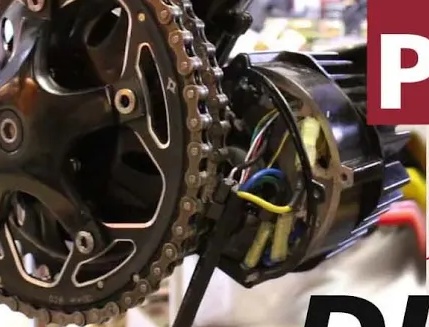 We get frequent inquiries from people who want to use the Phaserunner as an upgraded motor controller for the Bafang BBSHD mid-drive systems. In principle this can be done, and several years ago we produced a video on this topic and even made an adapter cable to facilitate the hookup.
We get frequent inquiries from people who want to use the Phaserunner as an upgraded motor controller for the Bafang BBSHD mid-drive systems. In principle this can be done, and several years ago we produced a video on this topic and even made an adapter cable to facilitate the hookup.
However, we found that most people embarking on that project did not understand the process, resulting in an extremely high support overhead from people trying to adapt BBSHD's for no particular reason. In fact almost 80% off all our phaserunner troubleshooting was tied up by the small portion of BBSHD users. The stock controller on a BBSHD is just fine, and if people have a failed BBSHD motor controller that they want to replace we recommend they replace it with a controller that is engineered specifically as a drop-in replacement.
Support Limitations
We give full warranty and support whenever the Phaserunner is purchased as part of a kit system from Grin and everything will come pre-configured. But we are limited in the help we can provide for people purchasing just the controller from us and then hooking it up to a third-party motor system. We've found a number of people have purchased the device without first looking into what the setup entails, both from a hardware and wiring perspective and also from a motor tuning perspective. Then they get in over their head or do silly things. Please read everything in the user manual and on this webpage, and watch our related videos before purchasing. If after that you think "Yes that's totally in my wheelhouse" then great. Otherwise, we'd recommend looking elsewhere for something with a narrower scope that is more plug-and-play for your particular system. A very generalized and configurable item like the Phaserunner by its very nature cannot be "plug-and-play".
Additional Details
We posted a fair amount of our test data in the endless-sphere forum during the development and initial pilot roll-out of the Phaserunner controller, and we've highlighted some of this data here:
- Efficiency comparison: Here we did direct comparisons on our dyno of a standard Infineon trapezoidal controller versus the Phaserunner controller running the same hub motor with the same battery current. You can see upwards of a 5% improvement in motor efficiency with the Phaserunner hub, as well as a steeper drop-off in torque vs RPM
- Field Weakening: Here are some discussions of the field weakening capability of the Phaserunner and how that affects both the no-load current draw and the unloaded RPM.
- eRPM Limit: Here we showed the Phaserunner controller running an RC outrunner motor at 72,000 eRPM's. However, ASI advised that beyond 60,000 eRPM the controller performance can suffer and we only did the testing unloaded.
- Thermal Rollback Limits: While the Phaserunner can put out 90 amps of phase current for short periods, within several minutes the heatsink will reach over 80°C and thermal rollback will kick in, automatically reducing the maximum phase amps. The maximum continuous phase current depends on installation details and airflow but is typically between 50-55A. The chart below shows the measured thermal rollback current when mounted with no additional heatsink to the downtube of a bicycle as a function of bicycle speed.
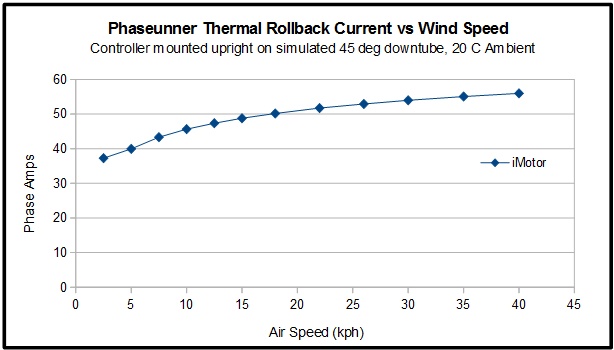
The use of extra finned heatsinks thermally linked to the Phaserunner base can increase this continuous phase current to nearly 70 amps, while the current limit if placed inside an insulated cavity or bag with no airflow at all will be much lower, around 30A.


 Canadian
Canadian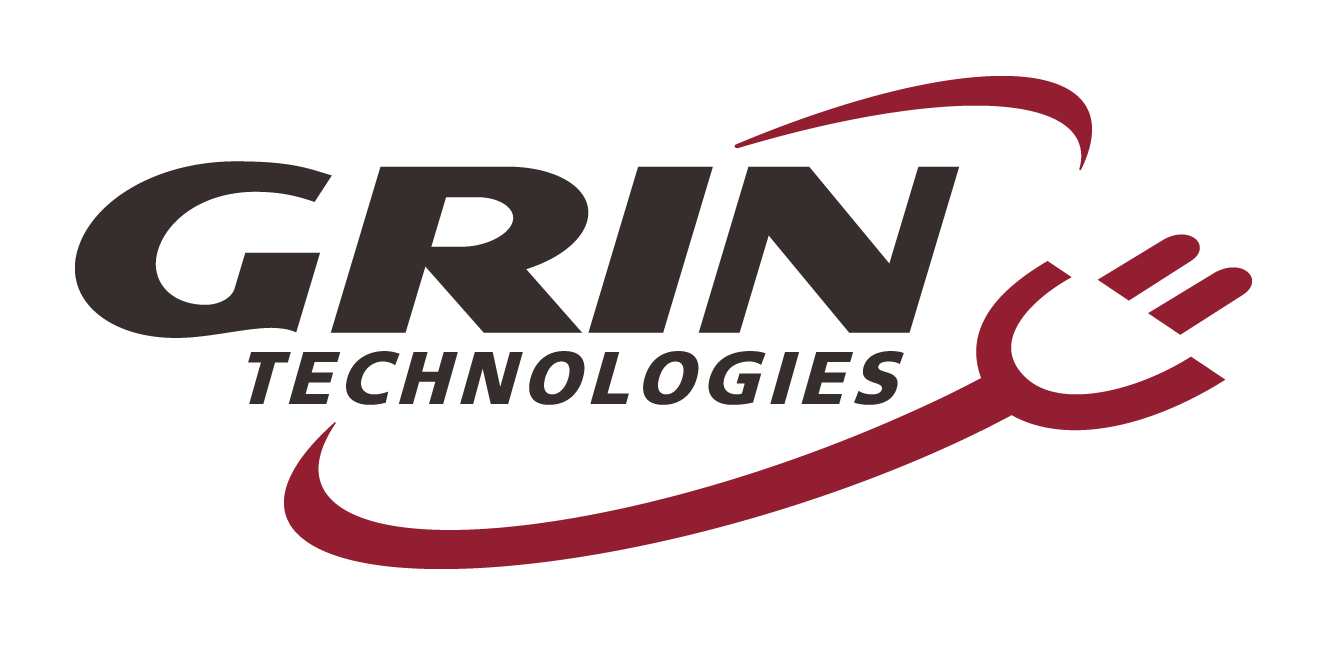
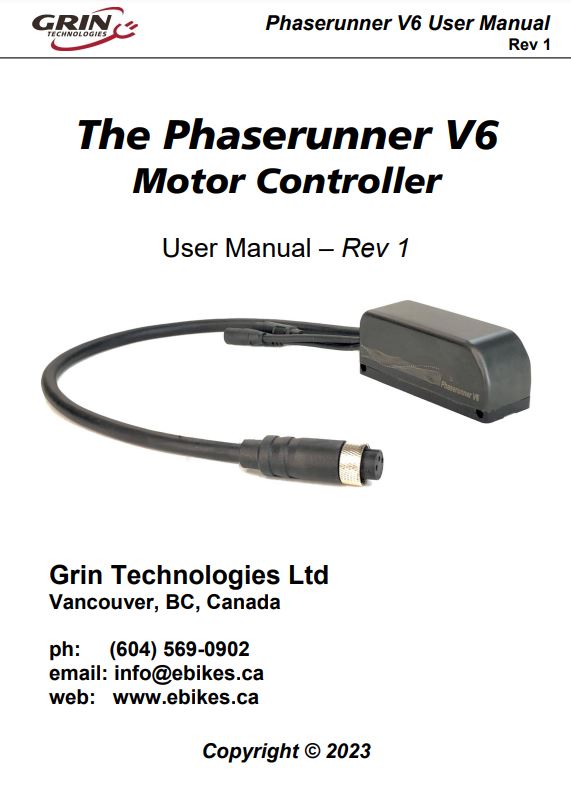
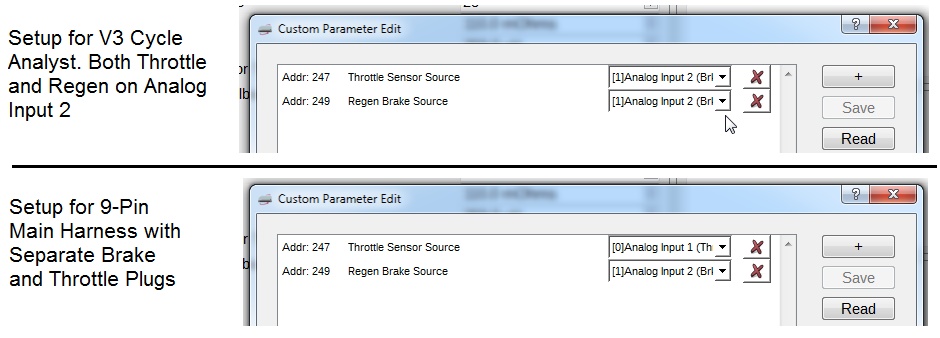
 Grin Tech Online Store
Grin Tech Online Store